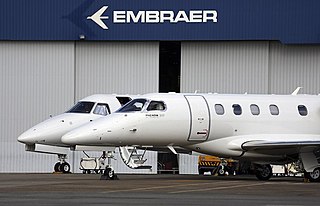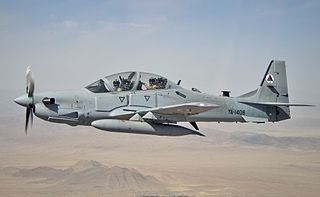 | |
| Short Take Off Utility Transport (STOUT) concept | |
| Role | military transport aircraft |
| Manufacturer | Embraer |
| Status | Prototype |
The Short Take Off Utility Transport (STOUT) is a light military transport aircraft concept proposed by Embraer.
 | |
| Short Take Off Utility Transport (STOUT) concept | |
| Role | military transport aircraft |
| Manufacturer | Embraer |
| Status | Prototype |
The Short Take Off Utility Transport (STOUT) is a light military transport aircraft concept proposed by Embraer.
In December 2019, Embraer and the Brazilian Air Force tackled the development of a light military transport aircraft. [1] Renderings of a proposed hybrid electric aircraft with STOL capabilities were shown in November 2020. [1] The Short Take Off Utility Transport (STOUT) would replace its 64 EMB-110 Bandeirante (average age of 38.3 years) and 19 EMB-120 Brasilia (average age of 26.5 years) with similar dimensions. [1] Powered by two turboprops also generating power for electric-driven propellers on wingtips, it would serve remote, unpaved 1,200 m (3,940 ft) runways and have a 1,310 nm (2,425 km) range. [1] It could carry ULD pallets for a maximum payload of 3 t (6,600 lb) loaded with a rear cargo ramp, or 24 paratroopers or 30 soldiers; or serve as an air ambulance. [1]
It would have a T-tail and a fuselage comparable to the 65-ft. 7-in. (20-m) long EMB 120 but wider. [2] Only concept studies are funded, a development program could follow after 2027 and commercial applications could include island hopping. [2]
Aircraft of comparable role, configuration, and era
Related lists

Embraer S.A. is a Brazilian multinational aerospace manufacturer that produces commercial, military, executive and agricultural aircraft, and provides aeronautical services. It was founded in 1969 in São José dos Campos, São Paulo, where its headquarters are located. The company is the third largest producer of civil aircraft, after Boeing and Airbus.

A business jet, private jet, or bizjet is a jet aircraft designed for transporting small groups of people. Business jets may be adapted for other roles, such as the evacuation of casualties or express parcel deliveries, and some are used by public bodies, government officials or the armed forces.

The Embraer ERJ family are regional jets produced by Brazilian aerospace company Embraer. The EMB145 was launched in 1989 as a turbofan-powered stretch of the EMB 120 Brasilia turboprop. It first flew on August 11, 1995 and it received its type certificate on December 10, 1996. The ERJ145 was introduced on April 6, 1997 and the shortened ERJ135 and ERJ140 were introduced in 1999.

The Embraer R-99 is the Brazilian Air Force military designation of the EMB-145-RS. It is an aircraft based on the ERJ 145 civil regional jet. The R-99 series are equipped with Rolls-Royce AE1 3007 turbofan engines. The military versions provide 20% more thrust than the civil version. The first flight was in 1999.

The Short Tucano is a two-seat turboprop basic trainer built by Short Brothers in Belfast, Northern Ireland. It is a licence-built version of the Brazilian Embraer EMB 312 Tucano.

The Embraer EMB 120 Brasilia is a twin-turboprop commuter airliner, produced by Embraer of Brazil.

The Embraer EMB 110 Bandeirante is a Brazilian general purpose 15–21 passenger twin-turboprop light transport aircraft designed by Embraer for military and civil use.

The Embraer EMB-505 Phenom 300 is a single pilot certified light business jet developed by the Brazilian aerospace manufacturer Embraer. It can carry up to 11 occupants.

The Embraer EMB-500 Phenom 100 is a very light jet developed by Brazilian aircraft manufacturer Embraer, type certificate is EMB-500. As of April 2017, 350 were in service in 37 countries.

The Embraer EMB 121 Xingu is a twin-turboprop fixed-wing aircraft built by the Brazilian aircraft manufacturer, Embraer. The design is based on the EMB 110 Bandeirante, using its wing and engine design merged with an all-new fuselage. The EMB 121 first flew on 10 October 1976.

The Embraer Legacy 600 is a business jet derivative of the Embraer ERJ 145 family of commercial jet aircraft.

The Rolls-Royce AE 3007 is a turbofan engine produced by Rolls-Royce North America, sharing a common core with the Rolls-Royce T406 and AE 2100, and an original development of the Allison Engine Company.

The de Havilland Canada DHC-5 Buffalo is a short takeoff and landing (STOL) utility transport turboprop aircraft developed from the earlier piston-powered DHC-4 Caribou. The aircraft has extraordinary STOL performance and is able to take off in distances much shorter than even most light aircraft can manage.

The Piper PA-31 Navajo is a family of cabin-class, twin-engined aircraft designed and built by Piper Aircraft for the general aviation market, most using Lycoming engines. It was also license-built in a number of Latin American countries. Targeted at small-scale cargo and feeder liner operations and the corporate market, the aircraft was a success. It continues to prove a popular choice, but due to greatly decreased demand across the general aviation sector in the 1980s, production of the PA-31 ceased in 1984.

PZL-104 Wilga is a Polish short-takeoff-and-landing (STOL) civil aviation utility aircraft designed and originally manufactured by PZL Warszawa-Okęcie, and later by European Aeronautic Defence and Space Company (EADS), who had acquired the original manufacturer during 2001.

The Embraer EMB 314 Super Tucano, also named ALX or A-29, is a Brazilian turboprop light attack aircraft designed and built by Embraer as a development of the Embraer EMB 312 Tucano. The A-29 Super Tucano carries a wide variety of weapons, including precision-guided munitions, and was designed to be a low-cost system operated in low-threat environments.

The Embraer/FMA CBA 123 Vector was a 1990 turboprop aircraft designed for regional flights, to carry up to 19 passengers. The program arose from a partnership between the Brazilian company Embraer and the Argentine FMA. The project was an advanced turboprop aircraft for its time, including advanced technology in avionics, aerodynamics, and propulsion.

The Embraer EMB 202 Ipanema is a Brazilian agricultural aircraft used for aerial application, particularly crop dusting. It is produced by Indústria Aeronáutica Neiva, a subsidiary of Embraer located in Botucatu, Brazil. The latest version of this aircraft is the first ethanol-powered fixed-wing aircraft, which could give it an economical advantage over the gasoline version. The aircraft is widely employed in Brazil, having market share of about 80%, and the 1,000th delivery was completed on 15 March 2005. Besides aircraft, alcohol-conversion kits for gasoline-powered Ipanemas are also sold.

The Embraer EMB 312 Tucano is a low-wing, tandem-seat, single-turboprop, basic trainer with counter-insurgency capability developed in Brazil. The Brazilian Air Force sponsored the EMB-312 project at the end of 1978. Design and development work began in 1979 on a low-cost, relatively simple new basic trainer with innovative features which eventually became the international standard for basic training aircraft. The prototype first flew in 1980, and initial production units were delivered in 1983.

The Embraer C-390 Millennium is a medium-size, twin-engine, jet-powered military transport aircraft produced by the Brazilian aerospace manufacturer Embraer. With a load capacity of 26 tonnes, the aircraft can be configured to perform various conventional operations such as troop, VIP and cargo transportation, and more specialised logistical operations such as aerial refuelling as a tanker. It is the heaviest aircraft the company has made to date.